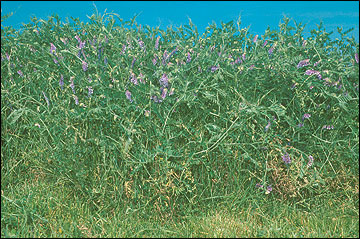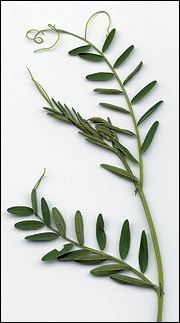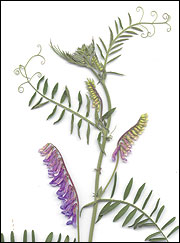Hairy vetch (Vicia villosa Roth)
Legumes
Hairy vetch is a winter annual legume used to a limited extent in Missouri. Hairy vetch is typically sown in late August or early September, and the plants generally form a crown before December. In spring, the plant produces weak branching stems or vines 3 to 6 feet long. Hairy vetch is commonly used in conjunction with cereal rye or wheat for silage. However, it also works well for early spring pasture. It withstands trampling and provides grazing from mid-April through May. The feed value of hairy vetch is slightly lower than that of red clover or alfalfa. Well-nodulated hairy vetch can enrich the soil with 60 to 120 lb/acre of nitrogen through nitrogen fixation. The primary limitation to the use of hairy vetch is that it produces forage only during spring when many other forages are also productive.
 Hairy vetch
Hairy vetch
 Yield distribution of hairy vetch in Missouri.
Yield distribution of hairy vetch in Missouri.
- Origin: Southern Europe
- Adaptation to Missouri: Statewide
- Growth habit: Climbing, prostrate, winter annual.
- Leaf: Pinnately compound terminating in a tendril, each leaf with 10 to 20 pubescent elliptical leaflets.
- Stems: Viny, slender, generally pubescent.
- Stipules: Small, narrow, and pointed.
- Flowers: One-sided, long peduncled raceme, usually purple or blue, 20 to 32 florets
- Fertilization: No N needed if nodulated. Maintain 30 lb P/acre and 250 lb K/acre.
- Timing of production: 80 percent of annual production between March 15 and May 15.
- When to begin grazing: In spring once the vetch reaches 6 inches or more in height.
- When to cut for hay: Early bloom.
- Lowest cutting or grazing height: 3 inches

